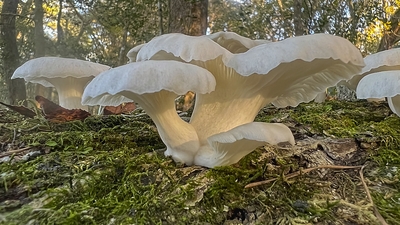
Mushrooms
Among the interesting things in nature that I have found to photograph are mushrooms. They come in many shapes, sizes and colors and are ephemeral in that what we see popping up out of the ground or attached to wood is only the fruiting body of a much larger hidden fungus and typically only lasts long enough to release the reproductive spores.
Depending upon the mushroom species spores are produced by various structures. Probably the most common and best known are gills. These are thin membranes under the cap in a radial pattern extending more or less from the stem to the rim. The Jack O'Lantern mushrooms above are an example of gilled mushrooms.
Another type of mushroom has pores instead of gills with the underside of the cap having the appearance of a dense sponge. The bolete family are an example of fungi with pores and the goldstalk mushroom below shows this type of cap.
Another type of fungi are the ones with teeth instead of gills or pores. These include the coral fungi, so named due to the resemblance to some ocean corals. This beautiful specimen, called a crown-tipped coral, was photographed in Taylor Hollow, a Nature Conservancy Preserve in Tennessee.
Like the boletes, polypores lack gills but instead have tubes that release the spores through the pores, or ends of the tubes. Some of the polypores take the form shown in the next photo of a hairy hexagonia and are known as shelf or bracket fungi.
The Amanita family (Amanitaceae) of mushrooms includes some of the most toxic fungi known and account for a huge majority of fatal poisonings caused by consuming mushrooms. The Amanita genus has many species of various colors. The fruiting bodies of the Amanitaceae develop inside an egglike enclosure called a universal veil. As the mushroom develops and breaks through this veil various remnants often remain on the cap, along the rim of the cap and/or along the stem and are sometimes visible near the base. In the photo below the veil is still complete from the rim the cap to the stem, enclosing the gills.
One of the more unusually colored mushrooms I have come across and photographed was this indigo milky while hiking in the Wakulla State Forest near Tallahassee, Florida. Also known as the indigo milk cap, blue latex will ooze from cuts or tears in this mushroom, with the latex slowly turning green upon exposure to air.
Recently the mushrooms I have most frequently come across and photographed seem to be oyster mushrooms. I have not been able to identify many of these to the species, although the mushrooms in the image below might be summer oyster mushrooms. I photographed these at Suwannee River State Park in North Florida.
I will close with my personal favorite mushroom photo that I made one August while camping in North Carolina. This is of a bolete mushroom in the woods on the lower portion of Jackrabbit Mountain in the Nantahala National Forest. I believe that this is Lanmaoa pseudosensibilis, a bolete with no common name that was until recently classified as Boletus pseudosensibilis.
Paul Rebmann
Feb. 25, 2024